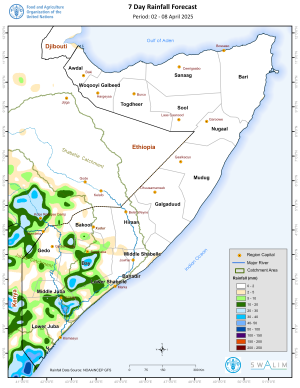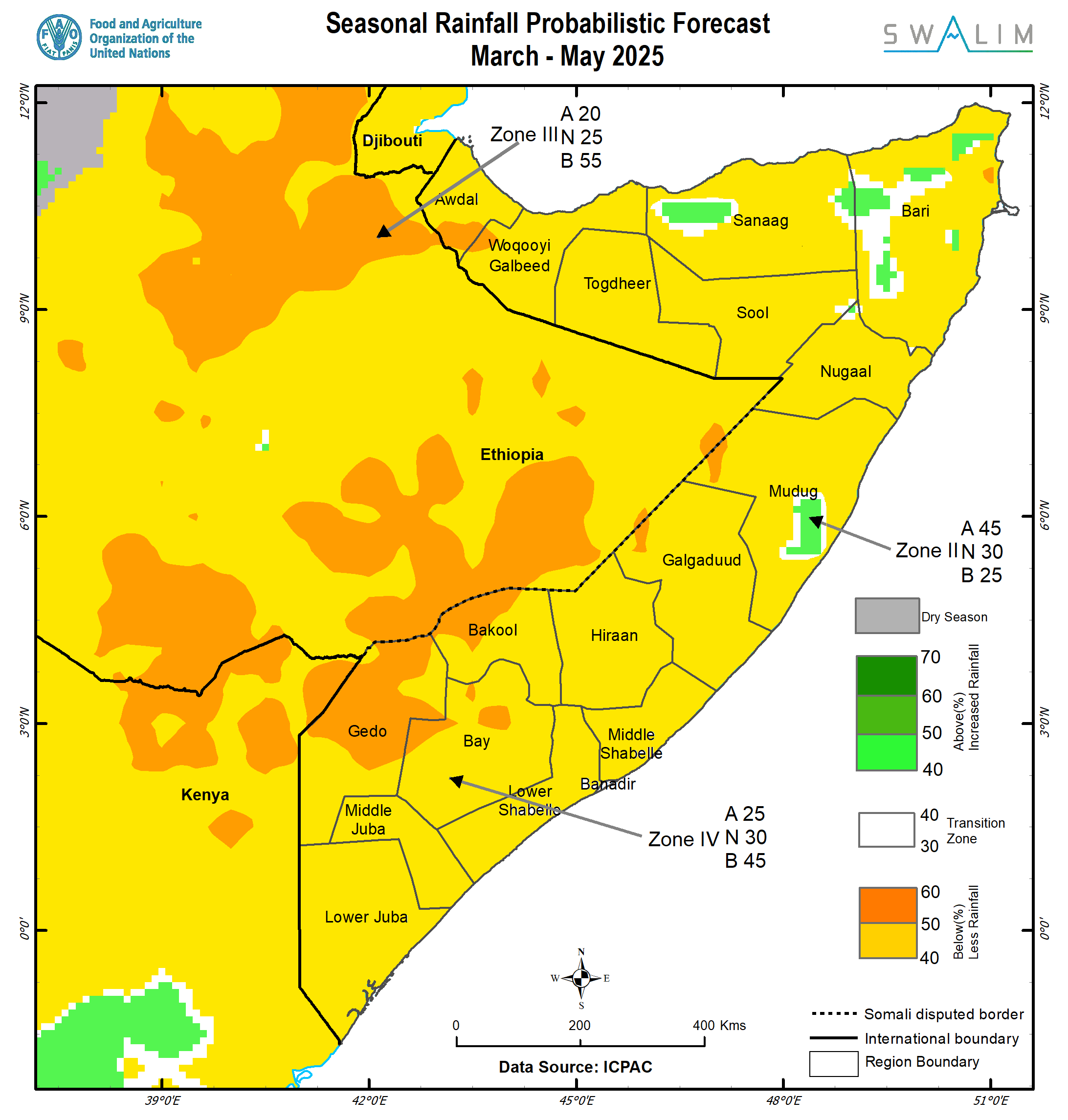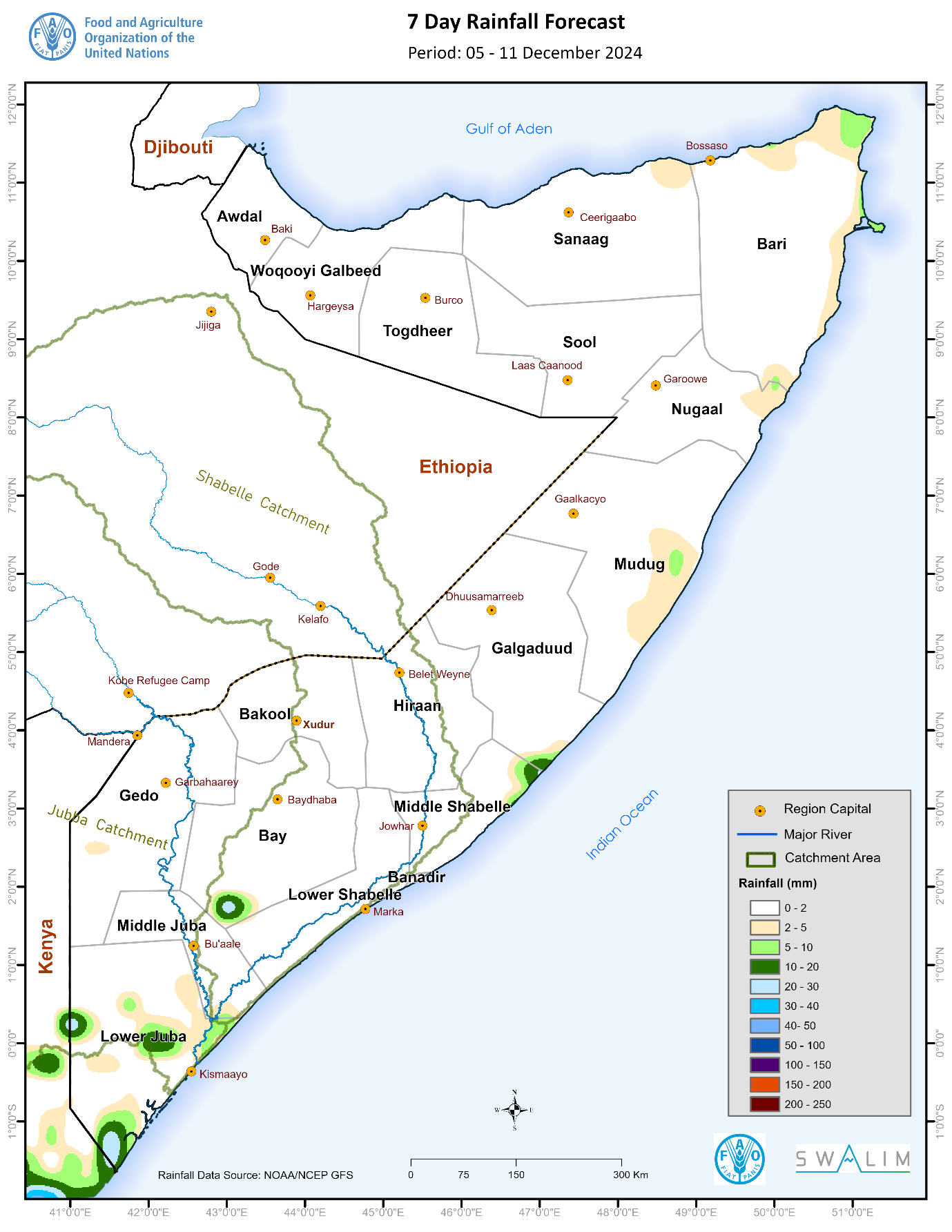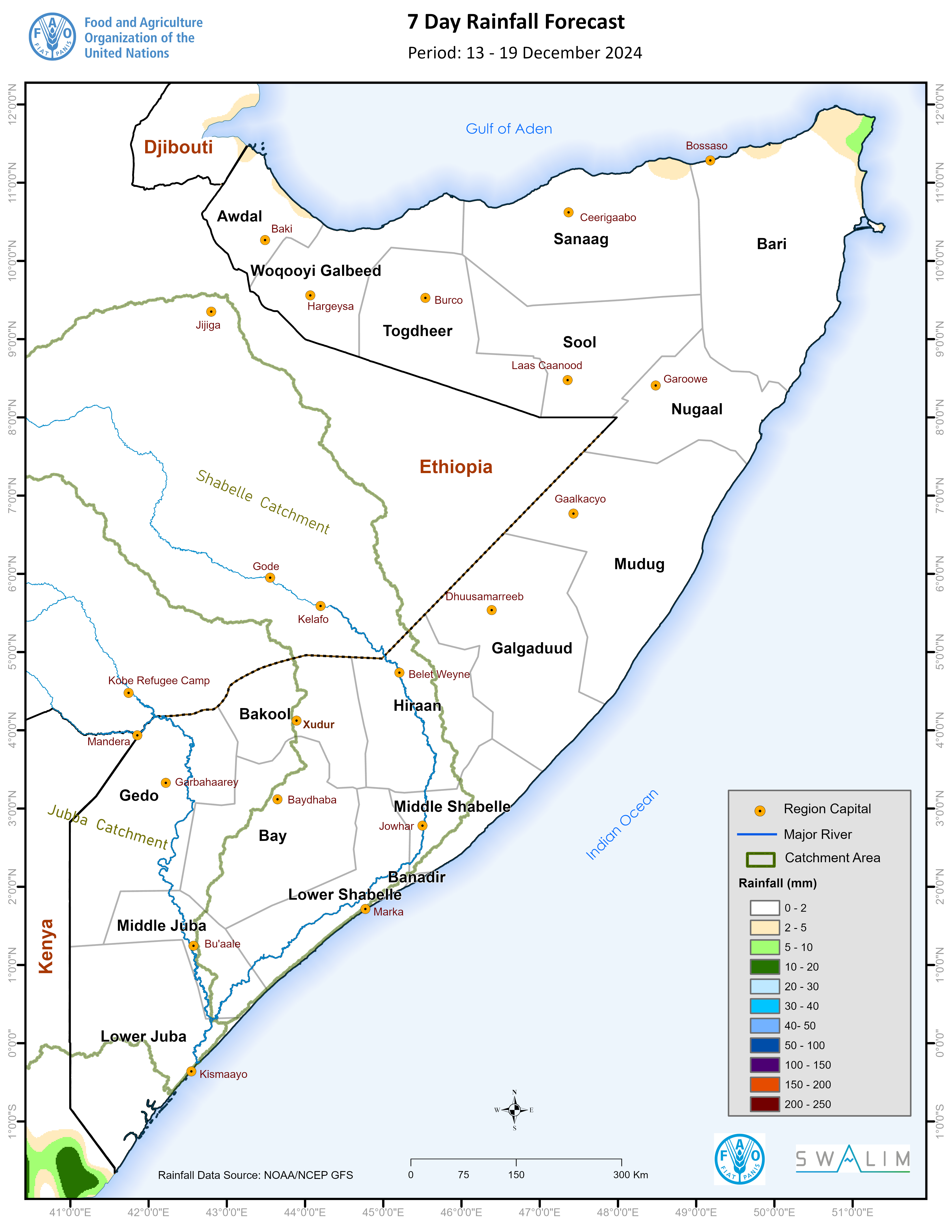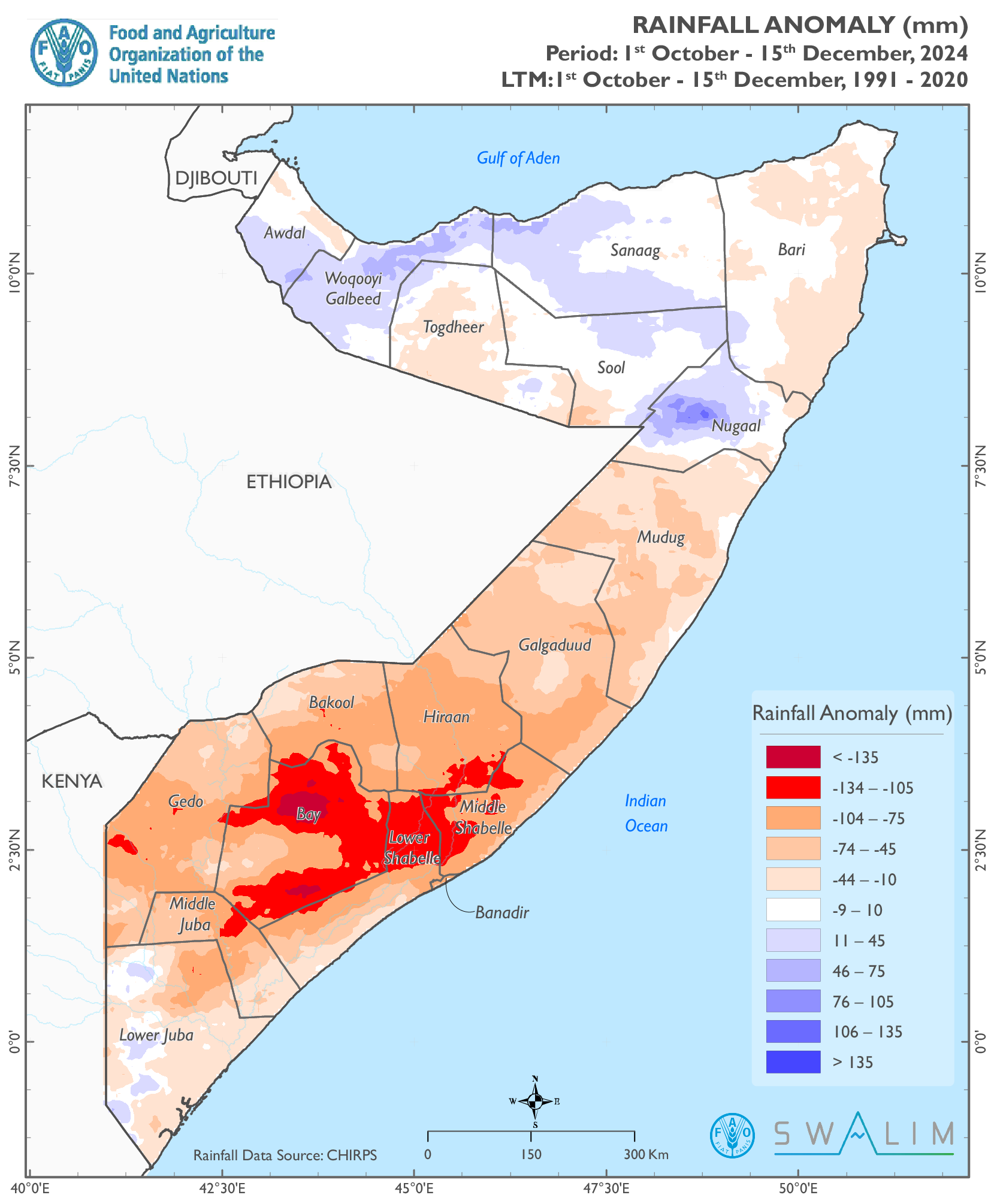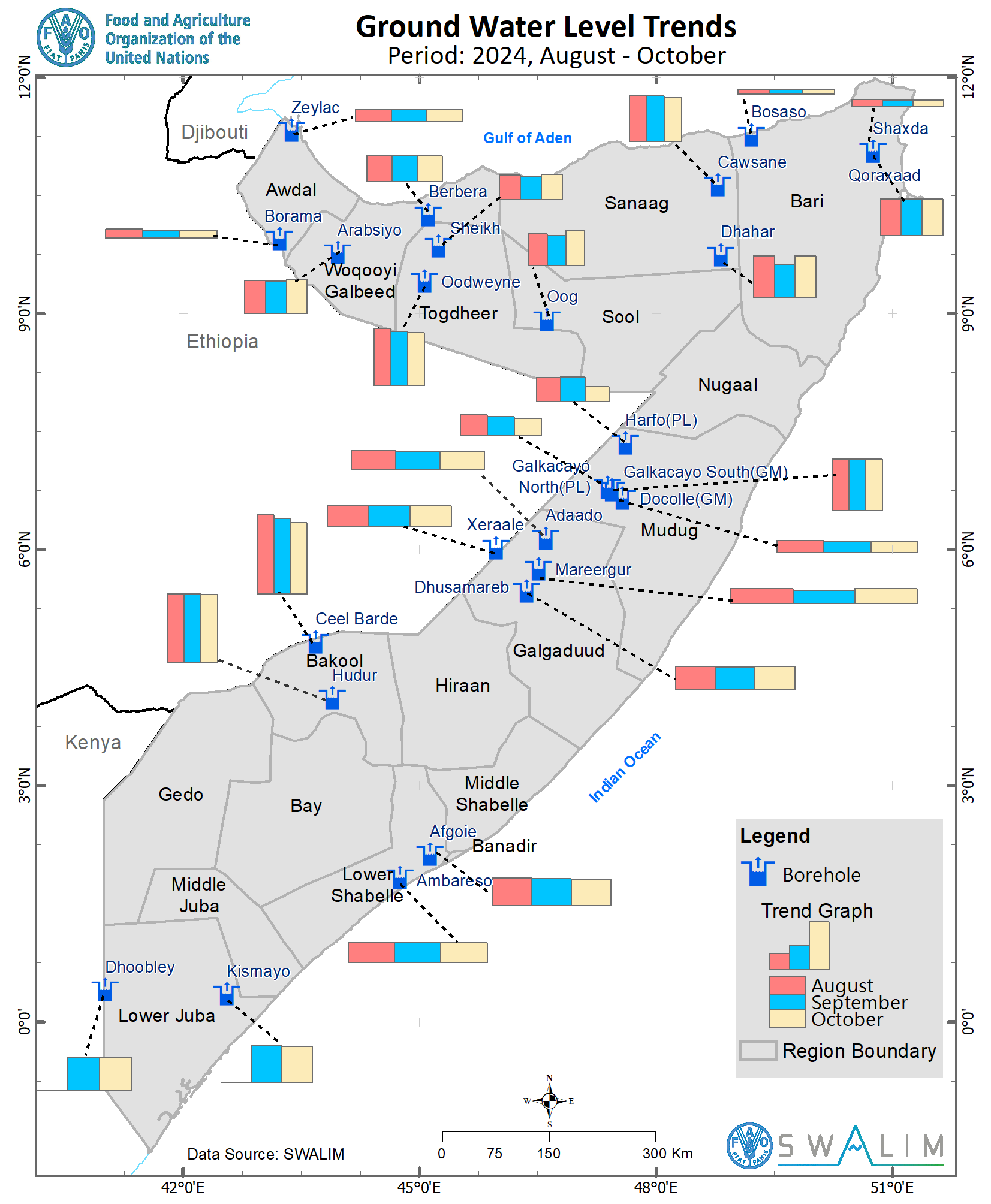Library Catalog
Latest Documents and Publications listed. Use search terms in the box below to find what you need
Somalia Rainfall Forecast – Issued 02 April 2025
Based on NOAA-NCEP Global Forecasting System (GFS), light rains are expected in some parts of Jubaland and South-Central with most parts of Hirshabelle, Galgmudug, Puntland and Somaliland remaining dry. The present position and strength of the Madden Julian Oscillation (MJO) and its evolution is not likely to favor occurrence of heavy rains within the forecast period.
The temporal and spatial distribution of the forecast rainfall (Map 1) are as follows:
Light cumulative rainfall of less than 50 mm is forecast over most parts Middle Juba region particularly Buaale district; most parts of Lower Juba region particularly Kismaayo districts, southern parts of Badaadhe and eastern parts of Afmadow district; some parts of Gedo particularly Ceel Waaq district, eastern parts of Garbahaarey district and southern parts of Baardheere district; some parts of Lower Shabelle particularly Qoryooley district; some parts of Bay region particularly Buur Hakaba district and northern parts of Baydhaba districts; some parts of Bakool region particularly Rab Dhuure district and western parts of Ceel Barde district. Light rains are also possible over eastern parts of Balcad district in Middle Shabelle and elevated areas in the central parts of Ceerigaabo district in Sanaag region. The rains over Lower Juba region particularly southern parts of Badaadhe district may intensify leading to moderate amounts (more than 50 mm) by the end of the forecast period. It is noteworthy that such light to moderate rains is likely to fall over the Juba River catchment.
Dry conditions are likely to prevail over vast areas in Hiraan, Middle Shabelle, Galgaduud, Mudug, Nugaal, Bari, Sool, Sanaag, Togdheer, Woqooyi Galbeed and Adwal regions. Dry conditions are also likely over most areas of Bakool region particularly Tayeeglow and Xudur districts; most parts of Lower Shabelle region including Wanla Weyn, Afgooye, Kurtunwaarey, Sablaale, and Baraawe districts; some parts of Bay region particularly Qansax Dheere district, northern parts of Diinsoor district and southern parts of Baydhaba district; most parts of Gedo region particularly Doolow and Luuq districts, western parts of Qarbahaarey district and northern parts of Baardheere district; some isolated areas in Middle Juba region particularly eastern parts of Saakow district; isolated areas of Lower Juba region particularly northern parts of Afmadow district. It is important to point out that such dry conditions with chances of light rains are expected over the Shabelle River catchment within and outside Somalia.
Publication Type:
Rainfall Forecast
Publication Date:
Author:
Corporate Author:
Status of river breakages along Juba and Shabelle rivers - issued March 2025
FAO-SWALIM has updated the status of the river breakages along the Juba and Shabelle Rivers using available Very High Resolution (VHR) satellite imagery and a Digital Elevation Model (DEM). Five types of breakages have been identified; Open, Overflow, Canal Breakage, Canal Intake Flooding and Closed with sandbags. The open breakages are those that are currently open as observed on the latest VHR image available. All the observations reported refers to the latest suitable VHR satellite image available, which is indicated in the online database. A legend/Key for further explanation of the different types of breakages is provided.
Along the Juba river 109 Open points, 1 Canal Breakage, 20 Canal flooding points, 87 Overflow points and 1 point closed with sandbags have been identified. Along the Shabelle river, a total of 98 Open breakage points, 2 Canal Breakages, 56 Canal flooding points, 94 Overflow points and 5 points closed with sandbags have been identified.
Users are advised that the methodology is biased towards Remote Sensing (RS) interpretation with only limited “ground truthing” due to access constraints. Open breakages might have been omitted in some cases where satellite images may not have been very clear (e.g. heavy cloud cover) or were not available.
Publication Type:
Map
Publication Date:
Author:
Corporate Author:
Gu 2025 Seasonal Climate Outlook and Action Plan for Somalia
The impacts of climate change have become more apparent in GHA’s cross-border regions, evident in the increased frequency and intensity of extreme weather and climate events, mainly recurring and severe droughts and floods. This national forum is, therefore, a much-needed platform that encourages exchange and interactions among pastoralists, farmers, climate information producers and users, and multi-institutional and multi-stakeholder collaboration. At the end of the workshop, the development and release of expected impacts and advisories based on the Gu 2025 seasonal outlook were the key outputs of the meeting.
The Gu season is crucial for all regions in Somalia, contributing up to 40-70% of annual rainfall in the southern and northwestern parts of the country, and 50-70% in the central and northern parts of the country. On average, the Gu season brings 200-300 mm of rainfall in the southern parts, 100-200 mm of rainfall over the central and northwestern parts, and 50-100 mm of rainfall over the northern parts of the country.
The Gu 2025 rainfall outlook shows a high likelihood of drier-than-normal conditions across all states and regions of Somalia, except for isolated highland areas in the Sanaag and Bari regions in the north and coastal parts of Hobyo district in Mudug region. Several areas in Gedo, Bakool and Galgaduud regions, northwestern parts of Bay region particularly Baydhaba district, eastern parts of Hiraan region, and areas of Mudug region bordering Ethiopia particularly Galdogob district, are predicted to have more than a 50 % likelihood of experiencing drier-than-normal conditions (Figure 1).
Publication Type:
Rainfall Outlook
Publication Date:
Author:
Corporate Author:
Somalia Rainfall Forecast – Issued 25 March 2025
This tail end of March marks the climatological start of the Gu rains with the arrival of the InterTropical Convergence Zone (ITCZ) from the southern hemisphere. Based on NOAA-NCEP Global Forecasting System (GFS), light rains are expected in the southern parts of the country with most parts of Somaliland and Puntland remaining dry. The status and forecast evolution of Madden Julian Oscillation (MJO) does not favor the likelihood of heavy rains within the forecast period.
The temporal and spatial distribution of the forecast rainfall (Map 1) are as follows:
Moderate cumulative rainfall of 50 mm and more is likely over very isolated areas in Dollow district, western parts of Luuq district and northern parts of Belet Xaawo district in Gedo region.
Light cumulative rainfall of less than 50 mm is forecast over most parts of Gedo region, and some parts of Lower Juba particularly Badhaadhe district, Bay particularly Baydhaba district, Bakool particularly Ceel Barde district, Hiraan particularly Belet Weyne town, Saakow district in Middle Juba region, Middle Shabelle including Banadir region. Light rainfall is also likely over the western parts of both Dhuusamareeb and Ceel Dheer districts in Galgaduud region, southmost parts of both Gebiley and Hargeisa districts in Woqooyi Galbeed region and elevated areas in eastern parts of Ceel Afweyn district in Sanaag region. It is important to point out that light to moderate rains is forecast to fall within the catchments of Juba River. Light rains are anticipated over the lower reaches of Shabelle River and moderate rains further up in Ethiopian Highlands.
Dry conditions are likely to prevail over vast areas in Mudug region, Nugaal region and Bari regions. Similarly dry conditions are also expected in Sool, most low-lying areas in Sanaag region, vast inland parts of Awdal region, Berbera district and northern parts of both Gebiley and Hargeisa districts in Woqooyi Galbeed region.
Publication Type:
Rainfall Forecast
Publication Date:
Author:
Corporate Author:
Review of Deyr 2024 Rainfall Performance, Jilal Status, Gu 2025 Outlook, and Implications on Livelihoods over Somalia
Contributing to about 60 % of annual rainfall, Gu season is critical for the Greater Horn of Africa (GHA) including Somalia. According to IGAD Climate Prediction and Application Centre (ICPAC), Gu 2025 is predicted to be characterized by below normal rainfall, normal to delayed onset and above normal temperatures. There is a 45 % likelihood that most parts of the country (Zone IV in yellow/orange in Map 4) will observe below normal rains. There is even a higher likelihood (55 %) of drier conditions being observed over Gedo, and some parts of Bay, Bakool, Hiraan and Awdal (dark orange). However, there are chances of very isolated above normal rains in some parts of Puntland. There is very low probability that cumulative Gu rainfall amount will exceed 200mm particularly over the Shabelle River Catchment. However, there are chances of exceedance over the uppermost and lowermost reaches of Juba River Catchment.
ICPAC have also reported that the status and predicted evolution of climate drivers in 2024/2025 closely resemble observations made in 2016/2017 and 2020/2021. The characteristics of the Gu 2025 are therefore expected to resemble those observed in 2017 and 2021.
Publication Type:
Rainfall Outlook
Publication Date:
Author:
Corporate Author:
Somalia Rainfall Forecast – Issued 06 December 2024
According to NOAA-NCEP GFS, light rainfall is expected over isolated areas in Lower Juba and Bay and along the eastern coastal parts of the country with dry conditions likely to prevail elsewhere during the coming week (Map 3). As the Inter Tropical Convergence Zone (ITCZ) moves further south, the Northeast monsoon will develop further with strengthened wind conditions particularly at Eyl district in Nugaal region and Bandarbeyla district in Bari region. The light rains along the narrow upper eastern coastal areas are therefore likely to be favoured by the moisture influx associated with these winds. However, the present and forecast forward propagation of the Madden Julian Oscillation (MJO) index is likely to suppress moisture availability with very low chance of significant rainfall in the next 2 weeks.
The temporal and spatial distribution of the forecast rainfall (Map 3) are as follows:
Light cumulative rainfall of less than 50 mm is forecast over isolated areas in Lower Juba region and in Dinsoor district in Bay region. Similar rains are likely over a narrow strip along the eastern coastal parts of the country particularly at the following areas: Adan Yabaal district in Middle Shabelle region, Ceel Dheer district in Galgaduud region, Hobyo district in Mudug region, Eyl district in Nugaal region, and Bandarbeyle and Caluula district in Bari region.
Dry conditions are likely to prevail over the rest of the country particularly Gedo, Bakool, Lower Shabelle, Hiraan, Sool, Sanaag, Togdheer, Woqooyi Galbeed and Awdal regions and inland areas of the following regions: Middle Shabelle, Galgaduud, Mudug, Nugaal and Bari.
Publication Type:
Rainfall Forecast
Publication Date:
Author:
Corporate Author:
Somalia Rainfall Forecast – Issued 13 December 2024
According to NOAA-NCEP GFS forecasts, only very light rains (<10 mm) are expected over extremely narrow northern coastal parts of Somalia during the coming week (Map 2). Dry conditions will dominate the rest of the country as Somalia remains under a La Niña Watch phase.
As the Inter Tropical Convergence Zone (ITCZ) moves further south, the Northeast monsoon will develop further with strengthened wind conditions particularly at Eyl district in Nugaal region and Bandarbeyla district in Bari region. The light rains along the narrow northern coastal areas are therefore likely to be favoured by the moisture influx associated with these winds. However, the present and forecast forward propagation of the Madden Julian Oscillation (MJO) index is likely to suppress moisture availability with very low chance of significant rainfall in the next two (2) weeks.
Publication Type:
Rainfall Forecast
Publication Date:
Author:
Corporate Author:
Somalia Rainfall Forecast – Issued 20 December 2024
According to ICPAC WRF forecasts, light rains (of less than 10 mm) are expected over some areas in the north and south with chances of up to 50 mm over some areas in Lower Juba and Middle Juba regions during the coming week. Dry conditions will dominate the rest of the country as Somalia remains under a La Niña Watch phase. As the Inter Tropical Convergence Zone (ITCZ) moves further south, the Northeast monsoon will develop further with strengthened wind conditions particularly at Eyl district in Nugaal region and Bandarbeyla district in Bari region. However, the present and forecasted weakening of the Madden Julian Oscillation (MJO) index is likely to suppress moisture availability with a very low chance of significant rainfall in the next two (2) weeks.
Publication Type:
Rainfall Forecast
Publication Date:
Author:
Corporate Author:
Juba Shabelle Riverine Flood Advisory - Issued 11-Nov-2024
The levels along Juba River have demonstrated notable variations when compared to the long-term mean (LTM) and last year’s El Niño-influenced behaviour. The level at Dollow is 40 cm above high flood risk level (5.00 m) today (11 November 2024) having rose sharply from 4.08 m on 4 November to 5.40 m today. A similar behaviour is expected at Luuq, where the level today is at moderate flood risk level (5.50 m) having rose sharply from 4.20 m on 4 November to 5.50 m today. This increase is occasioned by moderate cumulative rainfall over its catchment in the Ethiopian highlands and light rainfall within Somalia.
Moderate rainfall is expected over the Juba River catchment in the second week of November. However, with the further development of La Niña, these rains may be short-lived. Considering the lag effect of previous rains, the light to moderate rainfall forecast over Juba River catchment in Ethiopian Highlands and within Somalia will generate moderate runoff enough to sustain the high river flows at the upper reaches of Juba River within the coming week. While the high flows will be transmitted downstream to Bardheere, Saakow, Bualle and finally to Jilib in the long run, less intense rains are expected in the second half of November 2024.
There is therefore SUSTAINED HIGH RIVER FLOWS at Dollow and MODERATE RIVER FLOWS at Luuq with expected rise at Bardheere in the coming week. Although high river flows do not necessarily translate to riverine flooding, day-by-day rainfall and river level monitoring is advised.
Notable fluctuations have also been observed along the Shabelle River in recent weeks compared to the LTM, last year’s conditions influenced by El Niño, and even last week. After a slight drop of the high flows on 29 October 2024, the Shabelle River level at Belet Weyne today (7.00 m) is 50 cm above moderate flood risk level (6.50 m) and only 30 cm below high flood risk level (7.30 cm). This behaviour is driven by the occurrence of wet and dry spells in its catchment within Somalia and in the Ethiopian highlands. The levels today at Bulo Burte (5.35 m) and Jowhar (4.38 m) are still well below flood risk levels.
Moderate rainfall is expected over the Shabelle River catchment in the second week of November. However, with further development of La Niña, the rains may be short-lived. Considering the lag effect of previous rains, the light to moderate rainfall forecast over Shabelle River catchment in Ethiopian Highlands and within Somalia will generate moderate runoff enough to sustain the river flows at the upper reaches of Shabelle River within the coming week. While the high flows will be transmitted downstream to Bulo Burte, Jalalaqsi, Jowhar and finally to Balcad in the long run, less intense rains are expected in the second half of November 2024.
There is therefore SUSTAINED MODERATE RIVER FLOWS at Belet Weyne with expected rise at Bulo Burte in the coming week. Although high river flows do not necessarily translate to riverine flooding, day-by-day rainfall and river level monitoring is advised.
Publication Type:
Flood Alert
Publication Date:
Author:
Corporate Author:
Somalia Groundwater Monitoring Bulletin - Issued 14 Nov 2024
The El Nino driven 2023 Deyr rains followed by good 2024 Gu rains, led to replenishment of both surface and ground water sources in Somalia. The spatial variability of the rains however meant different implications on the different aquifers across the country. In Somaliland, the good temporal and spatial distribution of the rains ensured good recharge of ground water sources in most areas. The Karan rains that fall during the normal Hagaa dry period ensured continued replenishment of the ground water sources. South and central Somalia also received average to above average rains in most of the monitored stations. However in Puntland , the below normal rainfall received during this period led to minimal recharge of ground water sources.
Between May and September 2024, FAO SWALIM has installed and started the hourly monitoring of 35 boreholes across Somalia. The installation of the hardware is complete, and majority of the stations transmitting data online. There are however few with technical hitches either in the data recording or transmission, and these are being sorted to ensure complete network functionality by end of November 2024.
The installed groundwater level monitoring stations provide near real-time data on aquifer fluctuations, enabling efficient and effective management of the water resources. The collected data is analyzed to track changes in aquifer storage, identify areas of potential depletion, and assess the impact of pumping and recharge activities.
Publication Type:
Newsletter
Publication Date:
Author:
Corporate Author:
Pages
 RSS feed [compliant with the Agris AP] |
RSS feed [compliant with the Agris AP] |  Agris AP XML
Agris AP XML


